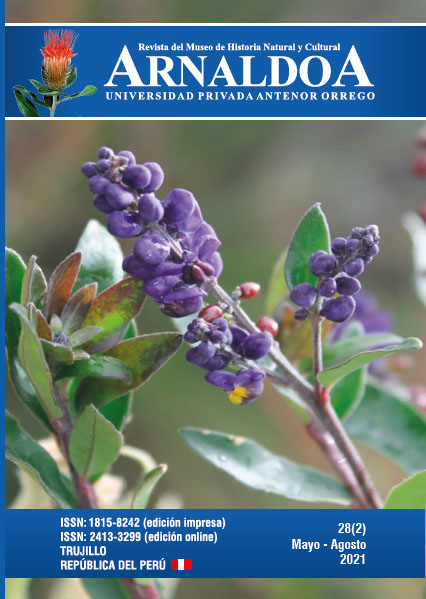Diversity and spatial variation of vascular plant in the Carquin-Hualmay marine coastal wetland(Lima – Peru)
DOI:
https://doi.org/10.22497/1596Keywords:
biological corridor, diversity indices, anthropogenic impacts, wetlands, vascular plantsAbstract
The Carquín-Hualmay wetland has, to date, the greatest vegetal richness per unit of area of all the evaluated wetlands on the coast of Lima. In the present study, its diversity and spatial variation was evaluated for each season of the year. For this, four samplings were carried out over a year (one per quarter), in which 30 transects were carried out using the Point Quadrat technique. The Simpson (diversity by transects), Shannon-Wienner (diversity by transects), Harrison (spatial variation), Jaccard (spatial variation) indexes and the diversity estimators Chao 2 (wetland diversity) and Jackknife 1 (wetland diversity) were calculated. In order to compare the data, the values of these indices (diversity by transects and spatial variation) and the richness (wetland diversity) of four other coastal wetlands of Lima were taken from the literature and statistical analysis was made. The diversity found in Carquín-Hualmay had average values of 0.39, 0.66, 0.17 and 0.27 for the Simpson, Shannon-Wienner, Harrison and Jaccard indices respectively; Chao 2 and Jackknife 1 had monthly average values of 23.98 and 22.58 respectively. These results were higher than those known in terms of diversity and spatial variation (just for Simpson and Harrison indexes) for the Puerto Viejo and Santa Rosa wetlands; the Paraíso wetland has greater diversity by transects and the Medio Mundo greater spatial variation. The richness of Carquín-Hualmay is higher than that of the Paraíso, Medio Mundo and Puerto Viejo wetlands but lower than the one of Santa Rosa wetland. Despite the fact that the Carquín-Hualmay wetland has a small area, it maintains high diversity values at different scales; human activity could contribute to diminish their community diversity and with the arrival non-native species, because of that is very important to conserve this wetland as part of the Pacific coastal corridor.
Downloads
Downloads
Published
Issue
Section
License
By submitting a paper to the journal, it is understood that the authors agree to transfer the publication rights to the journal once it is accepted.
It is permitted to share and adapt the contents of this journal in any medium or format always if the original source is properly cited and there are not commercial purposes.







